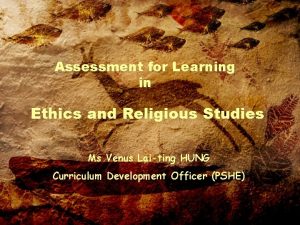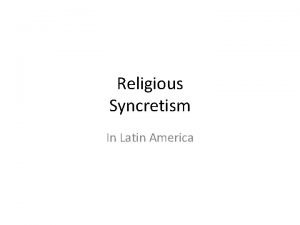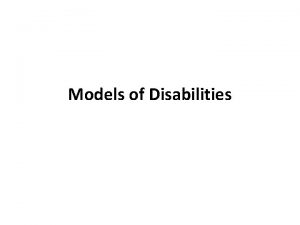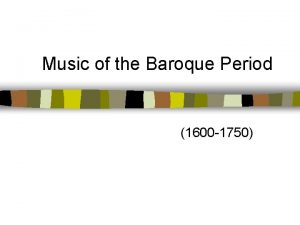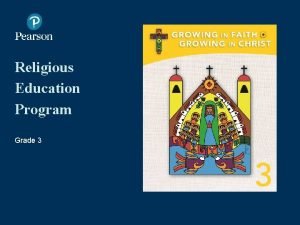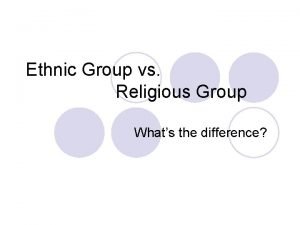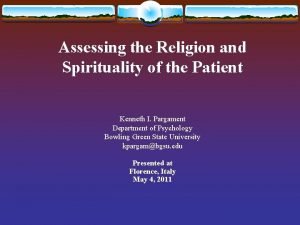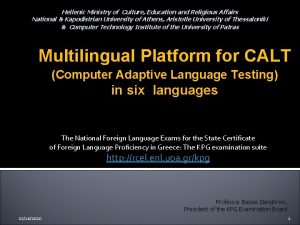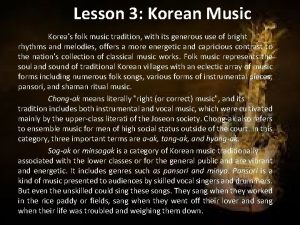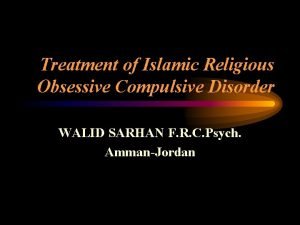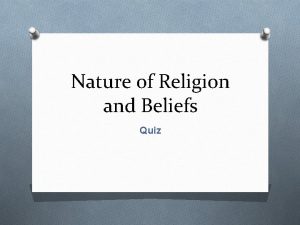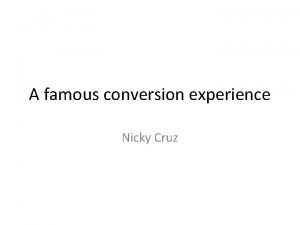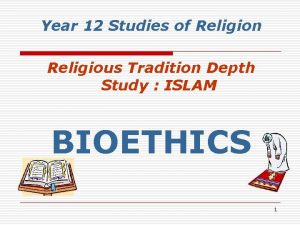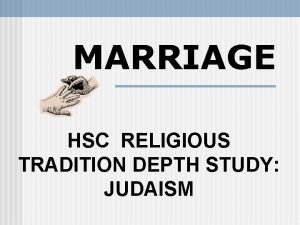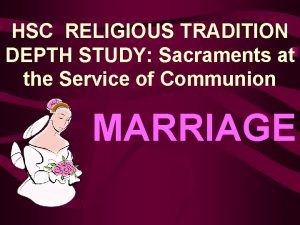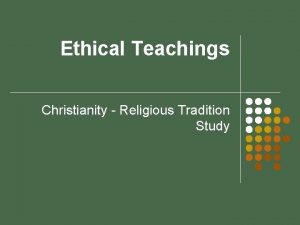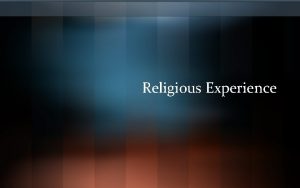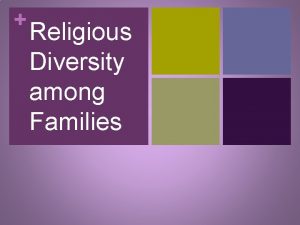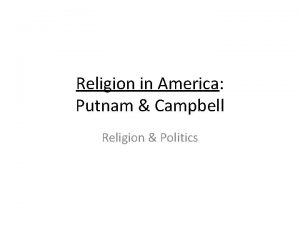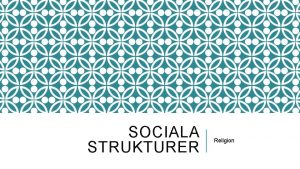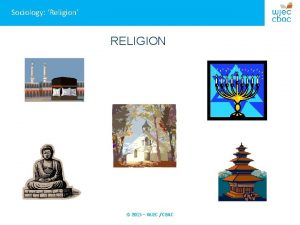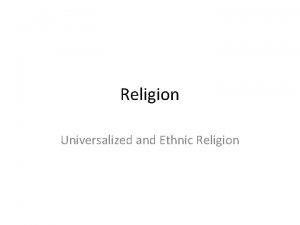Year 12 Studies of Religion Religious Tradition Depth














































- Slides: 46

Year 12 Studies of Religion Religious Tradition Depth Study : CHRISTIANITY BIOETHICS 1

Ethics Students learn about: n. ONE of the following area of ethical teaching in Christianity: -Bioethics -Environmental ethics -Sexual ethics 2

Ethics Students learn to: n. Describe and explain Christian ethical teachings on bioethics OR environmental ethics OR sexual ethics 3

How do we define ethics? n The justification for the reasoning behind human moral behaviour. ie. The principles that explain why some action or inaction is right or wrong 4

5

How do we define a moral? n The actual human moral behaviour ie. The name given to the action or inaction 6

7

Christian Ethics: Can be divided into two very different approaches. They are based on the concepts of : n Authority or n Natural law 8

Authority: Christian ethics take as sources of authority: n Scriptures ( Bible) n Tradition (Authority of Church Leaders) n Experience (Inspiration of the Holy Spirit) n Logic (reason) n 9

Love At the centre of Christian ethics is the idea of a love for all people. n Christian love is called agape – an empathetic attitude of caring for everyone and anything. n It is the kind of love shown in the Good Samaritan parable – Luke 10: 25 n 10

You have heard that it was said, Love your neighbour and hate your enemy. But I tell you: Love your enemies and pray for those who persecute you. Matthew 5: 43 -44 n This quote from the New Testament gives the basic and often repeated instructions from Jesus to his followers to love one another. He also supports the Old Testament commandment of loving God as God loves humanity. This concept is agape and is the concept of unconditional and whole-ofexperience love. 11

Jesus’ teaching of love Christian ethics are based on this. n Some people translate this as empathy or concern or respect for humanity in general and ‘your neighbour’ in particular. n 12

The Beatitudes Jesus’ Commandment of Love 13

A love which knows no measure: Having loved those who were in the world, he loved them to the end. ’ Jn 13: 1 14

The Commandments 15

How do we define BIOETHICS? The Study of the ethical and moral questions involved in the application of new biological and medical findings such as: n In Vitro Fertilisation n Stem Cell Research n Cloning 16

BIOETHICS… n n Bioethics is multidisciplinary. It blends biology, medicine, politics, law, philosophy and theology to bear on the complex interaction of human life science and technology. Religious bioethicists develop rules and guidelines on how to deal with issues from within the viewpoint of their faith tradition. The field of bioethics encompasses difficult private decisions made in clinical settings to controversies surrounding stem cell research to implications of reproductive technologies to broader concerns such as international human subject research, to public policy in healthcare, and to the allocation of scarce resources. 17

In Vitro Fertilisation http: //www. ivf. net. au/ivf. htm In Vitro Fertilization (IVF) is a treatment of infertility which involves the fertilization of eggs by sperm in the laboratory. IVF literally means 'fertilization in glass'. It is often referred to as assisted conception or in association with other related treatments more broadly as assisted reproductive technologies (ART). 18

In Vitro Fertilisation http: //www. ivf. net. au/ivf. htm IVF in humans was first successfully used in 1978. Since then more than one million babies have been born world wide from this treatment. It is by far the most successful and efficient management of infertility 19

20

In Vitro Fertilisation http: //www. monashivf. edu. au/default. asp? action=category&ID=398 Because In Vitro Fertilisation introduces technology into the creation of human life, it raises many questions. There are many complex questions that must be addressed by the community such as; Is a two-cell embryo a conscious living being? When does life begin? Is it when the sperm enters the egg? Is it when the zygote implants in the uterus? Is it when the primitive streak appears around day 14, OR, is it when the heartbeat becomes detectable at 6 weeks? 21

Stem Cell Research n n n Stem cells can be obtained from adult cells umbilical cord blood and cells in human embryos. These stem cells can develop into many different types of cells in the human body. Cells from embryos seem to have the ability to develop into all types of human cells whereas stem cells from other sources can develop into some types of cells. 22

Embryonic Stem Cells http: //www. biotechnologyonline. gov. au/human/stemcells. cfm n When an egg is fertilised by a sperm to make a human embryo, that single fertilised egg cell divides millions of times to form the six billion or more cells that make up our bodies. Most of these cells have undergone a process called differentiation that leads to them becoming specialised for a certain function, such as neurons (nerve cells) that convey electrical messages around the body. 23

Embryonic Stem Cells Life Office Polding Centre n n In 2002 the Catholic Archdiocese of Sydney made a $50, 000 grant to professor Mackay-Sim’s research team at Griffith University. Their research has shown that adult stem cells from the lining of the nose have similar abilities to embryonic cells, without the practical and ethical problems. They are easy to obtain; they can be derived from the patient’s own cells and do not require anti-rejection drugs; and they don’t grow in an uncontrolled way being less likely to cause tumour. In December 2005 the Catholic Archdiocese of Sydney made a further grant of $100, 000 to Dr Kaur of the Peter Mac. Callum Cacncer Centre in Melbourne for research into the use of adult stem cells to restore the skin of patients who have sustained severe skin injuries. 24

Ethics of Stem Cell Research n The overwhelming objection to stem cell research is that it involves the destruction of an embryo or foetus. For many this constitutes destruction of a potential human, and conflicts with religious and moral views held in our society. For others, the potential for this research to provide treatments and possibly cures for debilitating illnesses that have no cure and significantly impact on our way of life overrides this concern. 25

Ethics of Stem Cell Research n n n The other major ethical issue associated with stem cell research ties in with the combination of embryonic stem cell and cloning technologies, leading to generation of an embryo that is a genetic clone of the donor of the nucleus. What is critically different in this context is that an embryo is actually created for research or therapeutic purposes, and this raises a wider range of objections, in that a potential life is created for a specific purpose. Also of issue here is the purpose of this cloning, which would be done purely for the purpose of generating tissue for transplantation. The embryo generated could be allowed to continue development and could potentially lead to the birth of a new human if 26 implanted into a willing mother.

Lincon Stamp, Monash Institute for Medical Research; Australian Stem Cell Centre Premier Scholar and Joan Clark of Monash Micro Imaging This image shows the micro-architecture of a cluster of endoderm progenitor cells developed from human embryonic stem cells. The image, acquired by scanning electron microscopy (SEM) at 2, 200 X magnification, reveals cells that are decorated by a mass of plasma membrane projections. 27

Ernst Wolvetang, Monash Institute for Medical Research This close-up image shows the spectacular detail of a cluster of human embryonic stem cells grown on a mouse embryonic fibroblast feeder layer. These human embryonic stem cells have been artificially manipulated to develop into epithelial precursor cells. The red colour is a marker that identifies a protein present on particular epithelial cells. Epithelial cells form a thin tissue covering most of the internal and external surfaces of the body and its organs. The blue stain marks the nuclei of the cells. 28

Cloning http: //www. family. org. au/Cloning/whats_new. htm n The Prohibition of Human Cloning Act 2002 was passed just four years ago without a single dissenting vote in either the House of Representatives or the Senate. Section 9 of that Act provides that “A person commits an offence if the person intentionally creates a human embryo clone”. n Many politicians, including those who supported legislation to allow research using ‘excess’ human embryos created as part of the IVF programme, spoke strongly in favour of the Prohibition of Human Cloning Act 2002. 29

Cloning http: //www. family. org. au/Cloning/whats_new. htm Q 1. Don’t stem cells hold the promise of cures for spinal cord injuries and diseases like Alzheimer’s? Stem cells is a broad term for master cells that can grow and change to make about 250 types of specialised cells. There are two types of stem cells. Embryonic stem cells, found inside human embryos, are obtained by pulling apart the early embryo, destroying a human life in the process. Not only is this highly UNETHICAL; embryonic stem cells are “unstable” and can develop as life threatening tumours. There are no recognised cures from embryonic stem cells. Adult stem cells (or non-embryonic stem cells) occur naturally in the developing baby, children and adults as master repair cells. They are medically safe, producing new tissues for treating various diseases. Their use does not involve the destruction of human embryos, is ETHICAL, and has produced over 70 cures and treatments. The failure by scientists, the media and politicians to distinguish between the UNETHICAL use of embryonic stem cells and the ETHICAL use of adult stem cells has muddied the stem cell and cloning debate. 30

Cloning http: //www. family. org. au/Cloning/whats_new. htm Q 2. Why then are scientists pushing for legalisation of human cloning? Nearly all scientists involved in stem cell and cloning research have connections to strong business interests in promoting their particular technologies and scientific developments. The outcome of the current debate will have a major effect on the royalties and profits biotech companies reap from their patents. Biotech business is big business. 31

Cloning http: //www. family. org. au/Cloning/whats_new. htm Q 3. Can “therapeutic cloning” for medical research be considered acceptable as it does not involve the birth of a child? Scientists have attempted to create a spurious distinction between so-called “therapeutic cloning” – creating an embryo to be destroyed in medical research – and “reproductive cloning” to produce a child. In reality, to produce a human embryo is always “reproductive”; and to destroy an embryo is never “therapeutic”. The European Parliament has declared this spurious distinction to be a “linguistic sleight of hand. ” (Life Issues Inc, Sept/Oct, 2001) The Australian Health Ethics Committee once described it as lacking transparency and concealing the truth. So-called “therapeutic cloning” involves the manufacture of a new subclass of laboratory humans with the intention, right from the beginning, to exploit and destroy them as if they were laboratory animals. This would be the worst use of cloning technology. 32

Cloning http: //www. family. org. au/Cloning/whats_new. htm Q 4. What are the ethical boundaries to human cloning and embryo stem cell research? There are ethical boundaries that should never be crossed: · Creating embryos with the intention only to destroy them in laboratory experiments; · Cloning to create what is essentially an adult’s identical twin; · Cloning so as to harvest genetic material, tissues or organs from that embryo/foetus; · Creating animal and human genetic hybrids, given the serious risks involved. 33

The Human Embryo: Someone Or Something? 34

How should we treat human embryos? Christians believe that every human being is precious from the very beginning of his or her life, until natural death. Respect for the dignity of every human being gives rise to the recognition of the sanctity or inviolability of human life and a series of basic human rights. Human embryos should never be deliberately exploited or harmed. Life Office, Polding Centre 35

Human embryos matter! If embryos are human beings then the fact they are tiny and very young is no more morally relevant than that they are black or white. Every individual human life, every human being matters because our value our dignity, is found in our very being. Life Office, Polding Centre 36

Basic human goods/rights… n n n n n life & health knowledge experience of beauty work play friendship/ love integrity experience of the transcendent family 37

n Have no other Gods beside me Do not take the name of the God in vain Keep holy the Lord’s day n Do not kill n Do not commit adultery n Do not steal n Do not bear false witness against your neighbour n Knowledge/truth; Friendship n Do not covet your neighbour’s wife n Family n Do not covet your neighbour’s goods n Friendship n n n Experience of the transcendent n Life; Friendship n Family n Friendship 38

Not all ways & means of participation in a human good are reasonable and therefore ethical. n Don’t directly attack/ destroy a BHG/R in order to pursue another. n As Paul explains in the Letter to the Romans, (Rom 3: 7 -8), we cannot do evil so that good may come of it. 39

Not all ways & means of participation in a human good are reasonable and therefore ethical. n Remember that instances of a human good are equally valuable whether they are mine, yours or someone else’s. n Do unto others as you would have them do unto you. Tobit 4: 15, Mt 7: 12, Lk 6: 31 40

What are human rights? People have certain entitlements as human beings n ‘Human rights’ come with having a ‘human nature’ n Founded upon the dignity of the human person and the natural moral law n 41

life/ health Everyone has the right to life, liberty and security of person n Everyone has the right to a standard of living adequate for the health and well -being of himself and of his family n No one shall be subjected to torture or to cruel, inhuman or degrading treatment or punishment n 42

A Culture Of Life… Page 150 Catholic Ethical Teaching for Senior Secondary Students The Book of Genesis 1: 26, describes human beings as made in the ‘image of God’ and St Paul declares that the physical self is the ‘temple of the Holy Spirit’. The body and soul are not divided, but together comprise the whole person. This whole person is present from the moment of conception an from that moment has the same rights as every other human being. 43

A Culture Of Life… Page 152 Catholic Ethical Teaching for Senior Secondary Students In the encyclical Evangelium Vitae Pope John Paul II spelt out the need to build a ‘culture of life’ to address urgent problems that confront society today. What is urgently called for is a general mobilisation of consciences and a united ethical effort to activate a great campaign in support of life. All together we must build a new culture of life: new because it will be able to confront and solve today’s unprecedented problems affecting human life. Evangelium Vitae 95 44

The dignity of the human embryo Life Office, Polding Centre Belief in the dignity of the human embryo means no hoped-for therapeutic good is sufficient to justify the immorality of killing our very young. Biomedical science should be at the service of human life and dignity; human life and dignity should never be exploited for the sake of science. There must be ethical limits. 45

46
 Real depth and apparent depth
Real depth and apparent depth Aqa rs gcse past papers
Aqa rs gcse past papers Eduqas religious studies a level past papers
Eduqas religious studies a level past papers Eduqas rs gcse past papers
Eduqas rs gcse past papers Religious studies assessment
Religious studies assessment Spag stands for
Spag stands for Western religion vs eastern religion
Western religion vs eastern religion Studies of religion syllabus
Studies of religion syllabus The eucharistic prayer
The eucharistic prayer Paradigm shift from women studies to gender studies
Paradigm shift from women studies to gender studies Business report conclusion example hsc
Business report conclusion example hsc School leaving poem
School leaving poem Cognitive and non cognitive religious language
Cognitive and non cognitive religious language Religious syncretism in latin america
Religious syncretism in latin america Is a turban a religious symbol
Is a turban a religious symbol The moral/religious model of disability
The moral/religious model of disability Prescriptive ritual
Prescriptive ritual Religion
Religion Samskara novel characters
Samskara novel characters Sport
Sport Pearson religion grade 3
Pearson religion grade 3 English calvinists who sought a thorough cleansing
English calvinists who sought a thorough cleansing Religious and classical roots description
Religious and classical roots description What's the difference between ethnic and religious group
What's the difference between ethnic and religious group Religion
Religion Spiritual v religious
Spiritual v religious Religious vs spiritual
Religious vs spiritual Example of duplo in the philippines
Example of duplo in the philippines Hellenic ministry of education and religious affairs
Hellenic ministry of education and religious affairs How are ethnic groups and religious groups related
How are ethnic groups and religious groups related Why do territorial conflicts arise among religious groups
Why do territorial conflicts arise among religious groups Mco1700.23f
Mco1700.23f Tudor rollercoaster
Tudor rollercoaster Lotf last chapter summary
Lotf last chapter summary Religious ethics
Religious ethics Religious imagery examples
Religious imagery examples Robinson crusoe notes
Robinson crusoe notes Account for the present religious landscape in australia
Account for the present religious landscape in australia Used in both the folk and classical court music of korea
Used in both the folk and classical court music of korea Tolkiens elves
Tolkiens elves Dua for ocd
Dua for ocd Perspectives tok
Perspectives tok Religious archives examples
Religious archives examples Ka whakairia te tapu
Ka whakairia te tapu Religion question
Religion question Complete trust or confidence in someone or something
Complete trust or confidence in someone or something Why is nicky cruz famous
Why is nicky cruz famous




